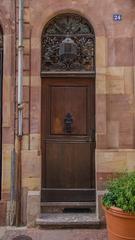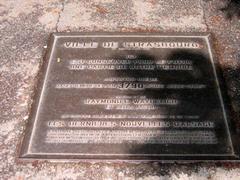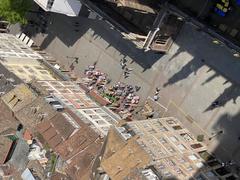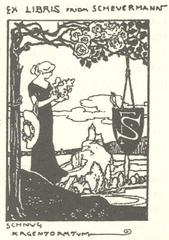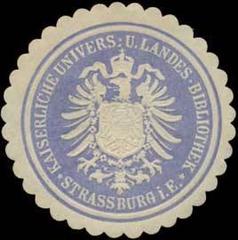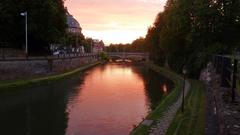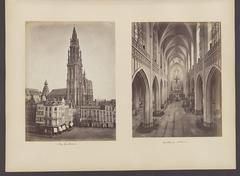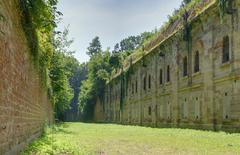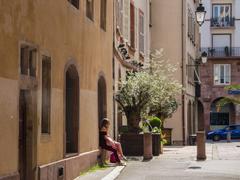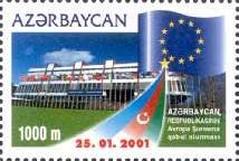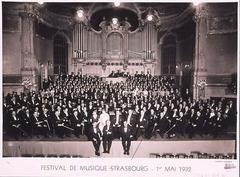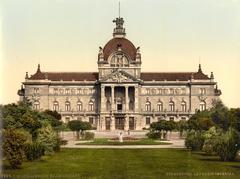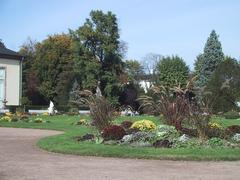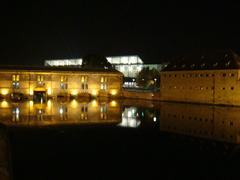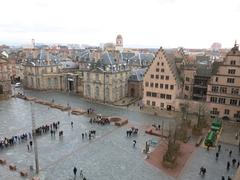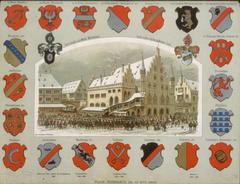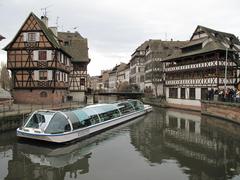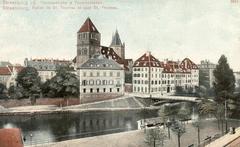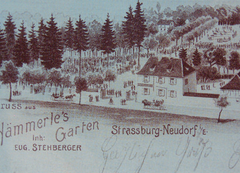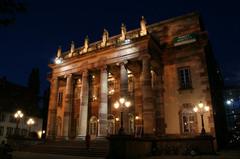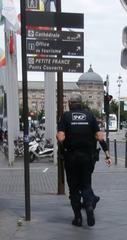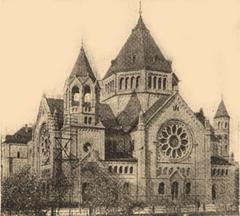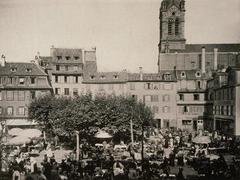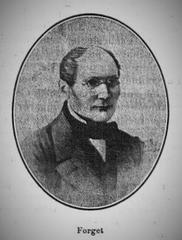
Visiting Guide for Place de la Cathédrale in Strasbourg, France
Publication Date: 01/08/2024
Introduction to Place de la Cathédrale
The Strasbourg Cathedral, known as Cathédrale Notre-Dame de Strasbourg, stands as a testament to the rich historical tapestry and architectural brilliance of Strasbourg, France. Situated in the heart of the Grande-Île district, the cathedral’s history stretches back to the Roman era, where it initially housed a Roman temple dedicated to Hercules before evolving through various architectural phases (Wikipedia). The cathedral’s transformation into a Gothic marvel began in the 12th century, with notable contributions from esteemed architects like Erwin von Steinbach (Postcards and Places).
Today, the Strasbourg Cathedral is not only an active place of worship but also a major tourist attraction, drawing visitors globally to marvel at its towering spire, intricate stone carvings, and the renowned astronomical clock. Its significance is further amplified by its inclusion in the UNESCO World Heritage List, alongside the historic center of Strasbourg (Catholic Shrine Basilica). This guide aims to provide a comprehensive overview of the cathedral’s history, architectural highlights, and essential visitor information to ensure a memorable visit.
Contents
- Introduction
- Historical Background
- Early Beginnings and Roman Influence
- The Carolingian and Romanesque Periods
- The Gothic Transformation
- Architectural Highlights
- The Astronomical Clock
- Historical Events and Restoration
- Modern-Day Significance
- Visitor Information
- Visiting Hours and Tickets
- Travel Tips
- Accessibility
- Special Events and Guided Tours
- Photographic Spots
- Nearby Attractions
- Frequently Asked Questions (FAQ)
- Conclusion
- Stay Up to Date
Historical Background
Early Beginnings and Roman Influence
The site of the Strasbourg Cathedral, located in the Place de la Cathédrale, has a rich history that dates back to the Roman era. The first known structure on this site was a Roman temple dedicated to the god Hercules. This temple was later replaced by a Christian church in the 4th century, reflecting the spread of Christianity throughout the Roman Empire. Archaeological excavations conducted between 1896 and 2014 have revealed remnants of these early structures, providing valuable insights into the site’s ancient past.
The Carolingian and Romanesque Periods
By the 8th century, a Carolingian church had been established on the site. This church was subsequently replaced by a Romanesque cathedral in the 11th century. The Romanesque cathedral was notable for its massive size and intricate stonework, which laid the foundation for the Gothic masterpiece that would follow. The construction of the Romanesque cathedral was a significant undertaking, reflecting the growing importance of Strasbourg as a religious and cultural center.
The Gothic Transformation
The transformation of the Strasbourg Cathedral into a Gothic marvel began in the 12th century. The construction of the current cathedral started in 1176, with the aim of creating a structure that would surpass its Romanesque predecessor in both scale and grandeur. The Gothic style, characterized by its pointed arches, ribbed vaults, and flying buttresses, allowed for taller and more light-filled structures. The cathedral’s construction continued over several centuries, with contributions from multiple architects, including the renowned Erwin von Steinbach, who worked on the cathedral from 1277 until his death in 1318.
Architectural Highlights
One of the most striking features of the Strasbourg Cathedral is its single, octagonal north tower, which was completed in 1439. Standing at 142 meters (466 feet), the tower was the tallest building in the world from 1647 to 1874. The cathedral’s west front, with its three portals surrounded by statues, was begun in 1277 and features a magnificent rose window completed around 1340. The interior of the cathedral is equally impressive, with highlights including the flamboyant Gothic-style pulpit, the astronomical clock, and the Pillar of the Last Judgement, an extraordinary example of architectural virtuosity carved by a master craftsman from the Île-de-France region.
The Astronomical Clock
The astronomical clock is one of the cathedral’s most famous features. Built in 1547 by a team of Swiss clockmakers, the clock is renowned for its intricate mechanism and daily procession of the Apostles, which takes place at 12:30 PM. The clock’s design reflects the scientific and artistic achievements of the Renaissance period and continues to draw visitors from around the world.
Historical Events and Restoration
The Strasbourg Cathedral has witnessed numerous historical events over the centuries. During the air raids on Strasbourg on August 11, 1944, the cathedral was hit by British and American bombs, causing significant damage. Repairs to the war damage were completed only in the early 1990s. In 1988, the cathedral was inscribed on the UNESCO World Heritage List, along with the historic center of Strasbourg, known as the ‘Grande Île,’ in recognition of its outstanding Gothic architecture.
In October 1988, during the city’s 2,000th-anniversary celebrations, Pope John Paul II visited the cathedral and celebrated mass. The bishopric of Strasbourg had been elevated to the rank of archbishopric a few months earlier, in June 1988. More recently, in 2000, an Al-Qaeda plot to bomb the adjacent Christmas market was thwarted by French and German police, highlighting the cathedral’s continued significance as a cultural and religious landmark.
Modern-Day Significance
Today, the Strasbourg Cathedral remains a symbol of the city’s rich history and cultural heritage. It is a major tourist attraction, drawing visitors from around the world to admire its architectural beauty and historical significance. The cathedral is also an active place of worship, with regular masses and special events held throughout the year. The surrounding Place de la Cathédrale is a bustling public square, providing a picturesque setting for the cathedral and serving as a hub for local and tourist activities.
Visitor Information
Visiting Hours and Tickets
The Strasbourg Cathedral is open daily from 7:30 AM to 7:00 PM, with extended hours in the summer. Entry to the main areas of the cathedral is free, but there is a small fee to access the exterior viewing platform, which offers stunning views of the city and the surrounding countryside. The viewing platform is open every day from 10:00 AM to 6:00 PM, except on Christmas Day, New Year’s Day, and Labour Day. Visitors can also enjoy the cathedral’s impressive light show during the summer months, which is free to watch and takes place several times in the evening.
Travel Tips
For those planning to visit the Strasbourg Cathedral, it is easily accessible by public transportation, with several tram and bus lines stopping nearby. For a more in-depth experience, guided tours are available, and the Strasbourg Pass offers benefits such as free entry to one museum and reduced prices for additional attractions. The pass also allows visitors to skip the queue for the astronomical clock display, which costs €3 to view and is highly recommended.
Accessibility
The Strasbourg Cathedral is committed to accessibility. Ramps and elevators are available for visitors with mobility challenges, ensuring everyone can experience the cathedral’s grandeur. Accessible restrooms are also located nearby.
Special Events and Guided Tours
The cathedral hosts various special events throughout the year, including concerts, art exhibits, and religious ceremonies. Guided tours are available in multiple languages, offering deep insights into the cathedral’s history and architecture. Check the official Strasbourg Cathedral website for the latest information on upcoming events and tour schedules.
Photographic Spots
Capture the beauty of the Strasbourg Cathedral from various vantage points. The viewing platform offers panoramic shots of the city, while the rose window and the west front are perfect for detailed architectural photography. The surrounding Place de la Cathédrale provides a picturesque setting for capturing the cathedral’s grand facade.
Nearby Attractions
The Strasbourg Cathedral is located in the heart of the UNESCO-listed Grande-Île district, which is the historic center of the city. Visitors can explore the narrow streets of the Quartier des Tanneurs (La Petite France), a picturesque neighborhood known for its half-timbered houses and winding canals. Other nearby attractions include the Musée de l’Œuvre Notre-Dame, which displays original works of art from the cathedral, and the Palais Rohan, a grand 18th-century palace that houses several museums.
Frequently Asked Questions (FAQ)
What are the Strasbourg Cathedral visiting hours?
The cathedral is open daily from 7:30 AM to 7:00 PM, with extended hours in the summer.
How much are tickets to the Strasbourg Cathedral?
Entry to the main areas of the cathedral is free, but there is a small fee to access the exterior viewing platform.
Are guided tours available?
Yes, guided tours are available and the Strasbourg Pass offers reduced prices for additional attractions.
Conclusion
In conclusion, the Strasbourg Cathedral and the surrounding Place de la Cathédrale offer a rich tapestry of history, architecture, and cultural experiences. Whether you are a history buff, an architecture enthusiast, or simply a curious traveler, a visit to this iconic site is sure to be a memorable experience.
Stay Up to Date
For the latest updates and more travel tips, download the Audiala mobile app, check out related posts on our blog, or follow us on social media!
